News
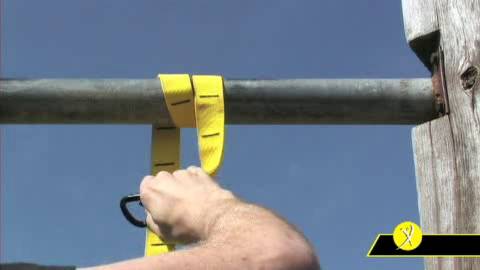
How Do You Set Up Your TRX Outside, Ask the Trainer
The sun is shining, the air is warm and it's time to head to the gym for a workout. Not so fast! Why keep yourself cooped up inside at the gym now that winter is on it's way out? The TRX is perfect to take with you to your local park, high school, beach or even your backyard, so you can enjoy spring without missing a workout. In this month's Ask the Trainer, we show you how to set up your TRX outside so you can workout anywhere. So what are you waiting for? Grab your TRX, and head into the great outdoors.
Q: "I'm excited to get outside with my TRX now that the snow is finally melting. I'm a little nervous to set it up outside, though. How can I be sure the TRX is set up correctly and in an area that is optimal for my workout.
A: For optimal use, choose a workout area roughly measuring eight feet long by six feet wide. Also, be sure you're on a flat, non-slip surface. For best results, you want to use an overhead anchor point that's seven to nine feet off the ground and strong enough to support your bodyweight.
To set up your TRX, clip the carabiner on the main body of the TRX to the bottom anchor loop of the yellow Suspension Anchor just below the black TRX badge. Do not clip it in any other loop of the Suspension Anchor. Attach the Suspension Anchor to the anchor point by wrapping it as many times as necessary to ensure the bottom of the Suspension Anchor hangs at about six feet from the ground. This is the ideal height to perform all TRX exercises. New to TRX training? Take our quick assessment quiz to get a beginner-friendly workout plan that ensures proper form and progression.
TAKE OUR TRAINING QUIZ
Clip the carabiner in the Suspension Anchor into one of its intermediate loops, or around the Suspension Anchor itself, and pull it tight to make sure it’s secure. A tip for attaching the TRX to a smooth bar or pole is to wrap the Suspension Anchor several times around it to prevent it from sliding side to side. And always remember to weight-test your TRX before using it by pulling hard on it.
TRX Safety Guidelines
Before each use, always inspect your TRX. Do not use a TRX with worn or damaged components. Replace worn or damaged components immediately.
Do not attach your TRX to an anchor point with sharp edges. For example, certain overhead metal beams or door hinges. Rubbing against a sharp edge will weaken or cut nylon.
Do not "saw" your TRX in a pulley-like fashion. Sawing will cause excessive wear of the TRX's stabilizing loop. If the yellow colored nylon begins to show through the black stabilization loop, replace your TRX immediately.
For athletes who perform sports outside such as tennis, soccer, football, cross country, track, etc., the TRX can be strapped to anything from a light pole, goal posts or chain link fences. Heading to the beach? Check out lifeguard stands, trees or volleyball posts. At your local park? Trees, calisthenic areas, posts or poles work great. The most important thing to consider when anchoring the TRX to an outside anchor point is to ensure it can bear your full bodyweight. Always weight-test before beginning your workout.
Lastly, make sure you have the right TRX accessories before heading outside to train. If your anchor point is either taller or wider than expected, use a TRX Xtender to accommodate those adjustments and ensure your TRX is still at optimal height. Have your best workout when you're being coached? Download one of our TRX workouts to take with you on your mobile device.
Try one of our TRX products today:
TRX® PRO4 SYSTEM
BUY NOW
TRX® HOME2 SYSTEM
BUY NOW
TRX® TACTICAL GYM
BUY NOW

How Do You Get Strong Shoulders, Ask the Trainer
This short TRX shoulder workout delivers big results for anyone who wants to build strength in their deltoids, traps and chest muscles.
TRX Clock Pull (alternating sides): 1 minuteTRX Swimmer Pull: 1 minuteTRX Push-up Plus: 1 minuteRest for One minute and repeat two to three times through.
Below are directions on how to perform each exercise:TRX Clock PullBenefits: Increases kinesthetic awareness, strengthens shoulder stabilizers
Adjust your TRX to mid length, and stand facing the anchor point. Walk your feet towards the anchor point and fully extend your arms to chin height.
With the right arm, perform a row while extending the left arm out straight to a T position. Allow both arms to straighten and lower the body back to start position between reps.
Perform 10 reps on the right side and then switch arms, this time performing a row with your left arm and extending the right arm out straight to a T position. Perform 10 reps on the left side. Keep your shoulders down and back throughout the movement.
TRX Swimmer PullBenefits: Improves lat engagement, strengthens posterior shoulder
With your TRX still at mid length, continue to stand facing the anchor point. Place your hands beside your hips, palms back, tension on the TRX and adopt an offset stance.
Lower your body down with arms straight, maintaining a strong plank position. Pull on the handles, drive your palms down and allow your body to move up toward the anchor point.
Slowly release back down to the start position between reps. Perform 10 reps.
TRX Push-up PlusBenefits: Improves serratus anterior engagement
Adjust your TRX to mid calf length and place your toes in the foot cradles. On your hands and knees, lift up into a hand plank position.
Lower your chest down, bend elbows to 90 degrees and keep your core engaged. At the bottom of the movement, drive through your palms and push up, keeping your body in a strong plank position.
At the top of the movement, push up a bit further than a normal push-up, causing your upper back to round slightly and your chest to cave. Perform 10 reps.
If you want more, be sure to check out our TRX for strength training page.
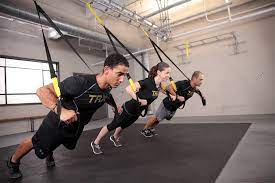
How Can I Be A TRX Instructor?
TRX® Instructors are among the very best group of educators in the world. Want to take your fitness career to the next level? Take our quick assessment quiz to get personalized recommendations for our instructor certification programs. They are part of an elite team of the most accomplished fitness professionals on the planet but to be a TRX instructor is much more than an accolade for a resume. This team of people has an unparalleled passion for the TRX® brand and for bringing our profession to the next level. They possess a deep training knowledge, a high personal physical competency and an unrivalled ability to coach and captivate in a learning setting.
TAKE OUR TRAINING QUIZ
These like-minded individuals are proud members of a global family who have lived through the crucible that is the TRX Instructor Development Process. They exemplify TRX® values and represent the TRX® brand at the highest level. In short… they are “grade A”, “premium cut”, “10th degree black belt”, TRX “badasses”l!
Sounds cool doesn’t it?!
“So when do I start?!”
… Hold your horses cowboy - It’s not that easy
The first step is to fill out the instructor application form but before you do, let’s talk pre-requisites. This is what you’ll find on the website but I’m going to provide a bit more “detail”.
• Bachelors Degree in Exercise Science or related field (special qualifications apply for Sports Medicine Instructors)
This one means you can check the box and pass “GO”. To put it in perspective, there are no shortage of graduate and even PhD degrees within the Instructor Cadre
• Current National Certification (ACE, NASM, NSCA etc)
Same as the first bullet point. The essence of “minimum requirement”
• Attended a one-day, 8-hour Professional Education Course
So you’ve attended a course. This is a good start but certainly does not differentiate you from the other 100,000 plus people who have attended courses. If you’re serious about becoming an instructor make the commitment to come to all of them. Now you’re in more “rarified air”. Additionally you need to consider coming to the major conferences such as IDEA or Can Fit Pro and attend TRX® sessions there. This will expose you to the very cutting edge of the TRX® Training Philosophies and also bring you into contact with our key subject matter experts.
• Proven leader in the fitness industry
Are you presenting your ideas at conferences? Have you published articles in magazines or newspapers? Do you have any DVD titles to your name or are you running a successful youtube channel, training blog, forum or podcast? In short - what are you doing to be a leader to the profession at large beyond your client / facility echo sphere? What do you contribute?
• 2-3 Years of presentation experience
It’s not enough to be a knowledgeable trainer or a popular group exercise instructor. A huge component of being a TRX instructor is the ability to engage, inspire and educate a group of your peers for 8 hours! This is no mean feat and it is a looming crux for many TRX Instructor aspirants. Hone your craft! The ability to present well is a true skill that requires both innate talent and hard work. There has been no shortage of prospective instructors who have been truly humbled by this element of our instructor development process.
• 6-8 years practical experience in strength & conditioning, fitness and/or physical therapy settings
You’ve got to know your stuff… period. TRX Instructors have all “been there, done that” and excelled. They have walked many miles in the shoes of their audience and in this way can relate and connect with them to provide an authentic and practical learning experience. One of the pitfalls we identify in our Instructor Training Courses is that it is a highly dangerous thing to present at the threshold of your knowledge. If the information that is being delivered is “bedrock” then it only takes one question for instructors to lose their credibility. Always be learning! TRX Instructors are continuously questing for new knowledge and information.
• TRX Core Member (recommended)
If you want to know the cutting edge of what is happening at TRX, TRX CORE is the solution. It’s where we put out our latest content and our newest ideas. Anyone who wants to be a TRX® Instructor should be not just a CORE member, but a contributing member of the CORE. Get involved in the Forums, answer some questions and differentiate yourself.
The other piece of this process that is absolutely crucial is that Instructor values must align with the TRX® Brand values. I think that the best test for this one is to understand the following question…
Why do you want to be a TRX Instructor?
HONESTLY answer this question. If your answer is centered more around your passion for the brand, love of coaching and thrill of seeing those around you develop you are likely on the right track.
Even with all of these things in place there is still no guarantee that there is an instructor position available in your area. The sad reality is that we cannot develop every person who is perfectly qualified.
We are thrilled that you want to be a part of our TRX Instructor Cadre. While the development process is extensive and challenging, and our quality standards are world class the experience of being part of this elite family of professionals is profound.
Contact us at instructorapplication@trxtraining.com with your instructor application. These applications will be evaluated and ranked and weighed against company needs.
I truly hope that this clarifies what the best development pathway is to make yourself the strongest TRX Instructor Candidate you can be.
Good luck with the process!

Honoring Navy SEAL Veteran Ryan Job
GET THE WORKOUT HERE
On September 24, 2009, Ryan Job, a Navy SEAL veteran and a close friend of the TRX family, passed away following surgery to address injuries he sustained while operating in Iraq.
As a Navy SEAL Team 3 operator and then as a veteran, Job never asked for recognition or praise from his fellow Americans. Yet those who had the privilege of knowing Job couldn’t help but walk away from any interaction with him without being inspired by his optimism, his determination, his unstoppable drive, and his unwavering commitment and dedication to family and country.
Job set an example that we should all try to follow. Modest, hard working and blessed with an indomitable spirit, Job embodied all of the best qualities of America's service members. Take our quick values assessment quiz to discover personalized ways to honor and carry forward these essential military virtues.
TAKE OUR TRAINING QUIZ
TRX CEO and founder Randy Hetrick, a former Navy SEAL, had the privilege of working with Job after his injuries. Hetrick developed a TRX Suspension Training program to help Job recapture the physical fitness he lost while recovering.
On Veterans Day, we celebrate all of our active service members and veterans. And we remember Job—a loving husband and son, a true patriot, a dedicated friend who was always quick with a laugh in the most dire of circumstances, a game warrior who never let the magnitude of the challenges he faced dampen his burning ambitions or dim his courageous approach to everything he set his mind to achieving.
He always pushed himself to go bigger, to be better, to get stronger. And he never, ever gave up.
*
On August 2, 2006, Ryan Job was on an otherwise typical SEAL foot patrol in Iraq when he heard the crack of a gunshot break the silence of a still night. It would be the last thing he heard before he went blind. “I was shot by a sniper through the right eye. The round fragmented inside my head and destroyed the right eye and the optic nerve of my left eye leaving me blind in both eyes. It also severed my olfactory nerve leaving me with no sense of smell or taste.” Two days later, Job woke up in the VA hospital in Bethesda, MD. “I couldn’t figure out where I was and why I could hear people but couldn’t see. I thought there were bandages on my face.”
It’s the kind of nightmare scenario no one, not even a Navy SEAL, is emotionally or physically equipped to handle gracefully. Yet less than two years later, Job fought his way back into shape and to the summit of Mount Rainier with the help of Hetrick and TRX.
Job completed the climb as part of an expedition with Camp Patriot, a nonprofit organization created by Navy vet Micah Clark to facilitate transformative expeditions and outdoor recreation for injured vets. Clark invited Job to join a Camp Patriot climbing expedition on Mount Rainier with several other vets, including an amputee and another blind soldier. Job trained hard using a program TRX developed for him leading up to the expedition. When the group reached the summit of Mt. Rainier in 2008, a fighter jet screamed over the summit to honor the achievement.
*
Job’s road to the SEAL teams and, eventually, to the summit of Rainier started in rural Washington state where Job spent his youth backpacking while tracking and hunting bears, deer, and elk in old growth forests. Job wrestled in high school and played rugby at Washington State, but never considered himself an outstanding athlete or student. His singular mission in life was to serve his country as a Navy SEAL.
“The only reason I went into the NAVY was to become a SEAL. I had a private pilot’s license and wanted to fly jets, but I wanted to do both: fly and be a SEAL. The thing that appealed to me most was the unconventional nature of the SEAL community compared to the normal military, the kinds of missions they do,” he said.
He wanted to be a SEAL so badly that he left Washington State in 2002 after three years of school to enlist in the Navy. He negotiated a clause in his enlistment contract that guaranteed no matter what, he’d get a shot at Basic Underwater Demolition School, or BUDS, the first testing phase for prospective SEALs. “Right after boot camp and my A school, I went straight to BUDS. The A school I picked was aviation ordinance, and the only reason I picked it was to get to BUDS more rapidly. I started BUDS four months after I went in.”
When he made it to BUDS, he found the challenge he’d been waiting for his whole life—and then some. “BUDS was a major kick in the nuts.” But he made it. After graduating from BUDS in 2004, he joined SEAL Team 3 and spent the next year training with his platoon. In April 2006, his platoon deployed to Iraq and Job spent the next four months performing special operations. “We did all types of SEAL-style missions. Let’s just say my platoon made our deployment worth it. If there was a bad guy, they paid the man.” That doesn’t mean he had fun doing it, though. “There is nothing about combat that I enjoy except the fact that I did my part of it.”
Then came the night of August 2, 2006 when a sniper’s bullet struck Job and took his sight, smell and sense of taste. Two days after being shot, Job was back in the States at the VA hospital in Bethesda where he faced surgery after surgery for the next six weeks. The community of current and former SEAL operators takes care of their own and a steady stream of SEALs past and present showed up to support Job.
Navy SEALs and other special operators have the fitness, mindset and skills of professional athletes and put those aptitudes to the test every day in combat. Before the accident, Job’s fitness and combat-readiness had been central to his identity. Now he couldn’t even go to the bathroom on his own.
“When I was shot, I went from being in the top 1% of most physically capable people in the world to being in the bottom 1% in a fraction of a second. I was skinny and weak and didn’t resemble a SEAL anymore. I spent almost two months flat on my back in a hospital bed with my muscles atrophying. It’s incredible how far backwards your fitness can slide during such a short period of time. I was pretty depressed about the physical state I’d deteriorated into and I knew I had months of inpatient rehab left to go to get me back to my normal life.” As trying as his situation was, Job never gave up hope. “In the SEAL teams, we had a saying. When all else fails, plan B is just make it happen. Never be a quitter.”
*
When CAPT Rick Woolard (Ret.), a former SEAL Commanding Officer visited Job in the hospital he found that while the sniper’s bullet had taken Job’s sight and ability to smell or taste, it did nothing to diminish his toughness. When they talked, the only wish Job expressed was a way to work out on his own. In a quest to fulfill Job’s wish, Woolard reached out to the SEAL community and got in touch with Hetrick.
Hetrick knew he had a solution for Job in the form of the TRX. “It was like, hey, here’s a training system he can do blind without any assistance. I knew he could challenge himself from the elementary level to the highest elite level. I liked that there wasn’t anything he could benchmark his effort against on the TRX. If Ryan had jumped on a bench press and could only bench 100 pounds when before he could bench 300, he might’ve been discouraged. With the TRX he was able to start from scratch and it gave him something to practice,” says Hetrick. When Job transferred to the Palo Alto VA in December 2006 for rehab to help him adjust to being blind, Hetrick had a special TRX workout protocol waiting for him.
Until Job got his own Suspension Trainer, he had to have someone else help him work out and transport him to and from the weight room. When he got a TRX, he was finally to train on his own again at home. The next step was conquering the beast of a training regimen that Hetrick had waiting for him.
“I spent weeks developing the routine,” says Hetrick. “I had this hypothesis that some of the exercises would be exemplary for blind people. I had a pair of blinder shades for flying in an aircraft and started with squat rows and curls and other stable positions. But that was no big deal. I could do it just as well with my eyes closed as well as open.
“It turns out you can do any of the TRX exercises with your eyes closed. You never have to take your hands off the system. I could go through a whole workout with my eyes closed because I know how to adjust it, how far it should be from the floor. You lie down, you put your feet in. You stand up, you hold onto the handles. You never lose contact with it.
“For someone without sight, the TRX serves the same purpose as a visible horizon. You know where you are because when you tug on the straps you know they’re up and in front of you.”
Hetrick met with Job and introduced him to the new workout protocol during a hardcore session on the TRX in the garage of Hetrick’s Bay Area home. Job was gassed, but thrilled. “The timing of when I started using the TRX was good for my specific injury because I was learning how to be blind,” said Job. “I had been blind six weeks and learning how to do everything blind. The TRX works on your spatial orientation, your body position, your balance, it’s something that teaches you how to do physical activity and coordinate yourself blind. Besides all of the strength training and physical training, it really enhanced my proprioception.”
*
Throughout his rehab in Palo Alto, Job continued to use the Suspension Trainer. When he finished that portion of his rehab, he settled in Scottsdale, AZ with his wife, to pursue a business degree at Jones International University. The TRX became a cornerstone of his training. “It’s really an efficient way to get a workout done. It’s something I always have an option to do,” he said at the time. “It totally eliminates my problem of transportation to and from the gym or who am I going to workout with? And where am I going to workout? I like the fact that you can stretch on it, too—flexibility is important to fitness also. I like the fact that you can travel with it. I like the fact that you can incorporate it into any training routine whether you’re a runner or swimmer or weightlifter. You really can develop a program on it for any type of sport.”
With the help of Camp Patriot, Job planned to climb Mt. Rainier. He’d never done any serious mountaineering prior to his Rainier attempt. In order to prepare his body for the challenge, he trained seven days a week and tackled a special mountaineering training program TRX designed just for him (the same workout found in the Ryan Job TRX Summit Workout).
Once on the mountain, Job found himself ready to face the challenge rising more than 14,000 feet in front of him. The Camp Patriot team had reached the summit with a blind veteran the year before in 2007. The guides used the same system they developed on that climb to enable Job to ascend safely. Job was roped to a sighted guide five feet in front of him. “I could follow him based on the tension and direction of the rope,” he said. A second guide followed five feet behind Job and verbally described the terrain. “I used trekking poles in both hands for stability and steeper terrain and for finding obstacles, just like I’d use a cane.” The system worked and Job and the team successfully made the summit.
“I attribute summit success and making it to the top to the team, first of all. Second, fitness was a huge key for me. Everyone else could see what they were walking up and take the right height, length and direction of steps. I’d have to pick my foot up a little farther each time, stride a little farther, and spend more time on each step just to identify where to put my foot. I had to use my upper body to pull myself up the mountain sometimes and support my upper body in addition to finding the footing in front of me with my foot, testing it and seeing if I could put my foot down safely. My process was twice as energy consuming as a sighted person.”
He didn’t let that get in the way of enjoying the climb, though. “I love the mountains, I love the outdoors. I was very tired at many points but I was happy the whole time, excited the whole time. I loved being able to go back up to Washington state because that’s where I grew up. I liked the cold air on my face. I’m very sensitive to sound now. I like the sound of things when there’s snow on the ground. It sounds very different. It’s muffled. Echoes sound different, but I can still hear when a cliff or rock wall is next to me. On the summit there’s nothing above your head and nothing on your sides, just entirely open space.” The team made it to the summit and back down to the parking lot in just four days. “I was recovered from each leg of the climb each day we did it. Once we got back down to the parking lot, I was ravenously hungry but by the time I was done eating the big mountain of food I was ready to go back up the mountain.”
The next adventure Job had planned after reaching the summit of Mt. Rainier was to complete a triathlon. He never got to accomplish that goal as complications from an operation to address his injuries took his life.
Today, we remember Job for his tenacity, for his courageousness and for the way he inspired us to be our best. No matter what he faced, he never gave up. He showed us what it means to be a truly strong human.
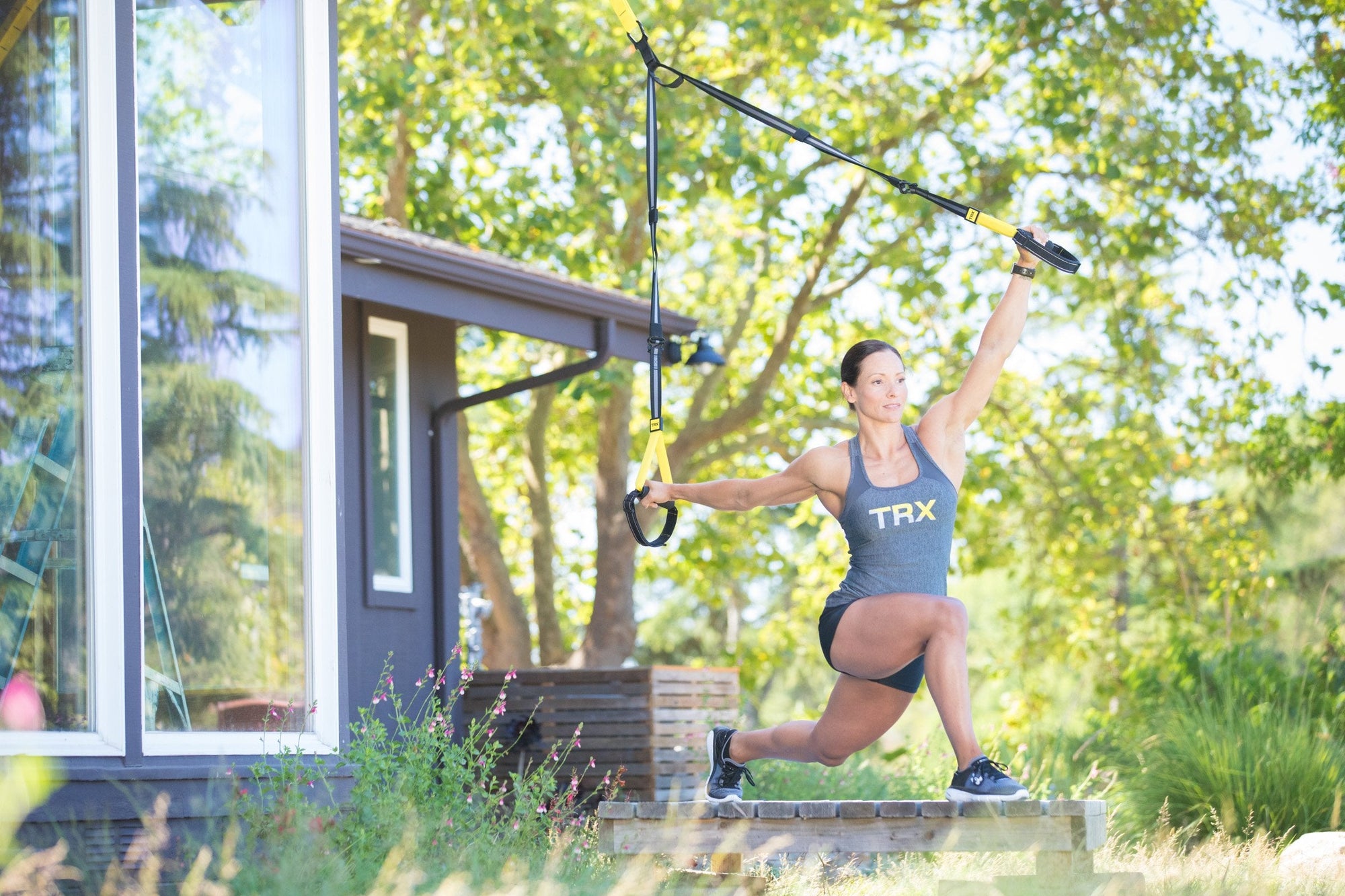
TRX
Home or Pro: Which Suspension Trainer Is Right for You?
TRX Training
If you have been clicking back and forth between the TRX HOME2 and PRO4 Systems while trying to decide which Suspension Trainer is right for you, we have the scoop on the differences between the two to help you choose.
When it comes to Suspension Training workouts, there’s no limit to the functionality of the two Systems. The basic design is the same: both rely on barrel lock adjusters to change the length of the straps, attach to an anchor point via a carabiner clip, have adjustable foot cradles, work with both the TRX Door Anchor and the TRX XMount, and come with one year’s access to the TRX App. If you love TRX Live workouts, you can follow along using either style of Suspension Trainer.
The main difference between the two options is the materials.
Because the TRX HOME2 was designed for personal use at home or on-the-go, it’s a little bit lighter weight (1.5 lbs) than the TRX PRO4 (2 lbs). The primary design difference, other than the color of the straps, is the handle. The TRX HOME2 SYSTEM has a slightly smaller, soft foam handle, while the TRX PRO4 SYSTEM has a more rugged, rubber grip handle. Because of the materials and designed with commercial use in mind, the TRX PRO4 grips dry more quickly when you disinfect them.
Both systems are designed to go anywhere and come with mesh carrying bags, but the TRX PRO4 straps have a locking carabiner to prevent theft. While the lock function is a feature that's nice to have, it’s unnecessary for most customers who work out at home.
Which TRX Suspension Trainer is right for you? That’s a personal choice. If you’re used to using the TRX straps at a gym, you’ve probably been using the TRX PRO4 SYSTEM and might prefer it for the sake of continuity. If you like to travel with your straps and tend to overpack, the half-pound-lighter TRX HOME2 SYSTEM may be a better fit. If the price is a concern, the TRX HOME2 retails for $50 less than the TRX PRO4.
No matter which style you select, you'll be bringing home the most versatile fitness tool on the market. Ready to get the most out of your investment? Take our quick fitness assessment quiz to create a personalized training plan that matches your goals. And if you've been looking to jumpstart your strength training routine, you can't go wrong with a TRX suspension trainer.
TAKE OUR TRAINING QUIZ
Try one out today:
TRX® PRO4 SYSTEM
BUY NOW
TRX® HOME2 SYSTEM
BUY NOW
TRX® TACTICAL GYM
BUY NOW
Start with your own workout regimen today or use the TRX Training Club to get hundreds of TRX exercises delivered to your phone from trained professionals.
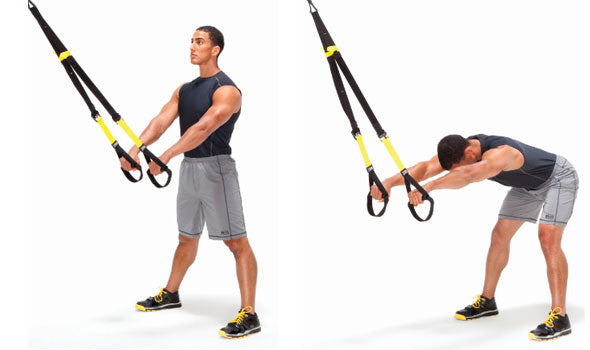
Hip Mobility and Hamstring Stretches: Summer Salutation Series Week One
Use this hip and hamstring mobility workout to help you get your summer body ready. This 15-minute mobility and stretching routine will unlock your body’s potential and help you get ready for a busy summer outside, on the beach, by the pool or on the trail.
This workout is the first in our Summer Salutation series, designed to help you get the most out of your summer with a boost of fitness and confidence. Want to find the perfect summer workout plan for your fitness level? Take our quick assessment quiz to get a personalized training program that'll help you reach your warm-weather goals.
TAKE OUR TRAINING QUIZ
The Workout:Perform each exercise for 60 seconds per exercise, minimal rest between exercises, 1-3 times through.
TRX Wall SlidesStand facing away from the anchor point with your hands in foot cradles and your arms over your head, bent at 90 degrees. Drive hands into foot cradles so there is no slack in the straps and slowly extend your arms directly over your shoulders. Slowly bend your elbows back to 90 degrees to return to the start position.
TRX Forward Lunge to I Fly (Alternating Legs) Stand facing away from the anchor point holding the handles with your hands and your arms straight out in front of you. Lunge forward until your front knee is bent at 90 degrees, letting the knee of your trailing leg kiss the ground. As you lunge down, your arms should go directly overhead, unloading your legs slightly so you can focus on the stretch. Brace your core, press your hands into the handles and drive through your front foot to return to the start. Reestablish your plank before repeating on the other side.
TRX Hip Hinge (Wide Stance)Stand facing the anchor point with the your arms extended in front of you pressing down on the TRX handles and your feet wider than shoulder width apart. Bend forward from the hips with a straight back, pushing your hips back and extending your arms forward. Drive your hips forward to return to the start position.
TRX Cossack StretchStand facing the anchor point with your feet wider than hip width apart. Bend one leg and lower hips toward ground while keeping the opposite leg straight. Allow the toe of your trailing leg to come up, creating a stretch through inner thigh. Keep your hips low and repeat on the other side.
TRX Overhead SquatStand facing the TRX with your hands extended over your head in the foot cradles pulling back so that there is tension on the straps. With your feet shoulder-width apart and your hands still overhead, squat down until your thighs are parallel with the ground.
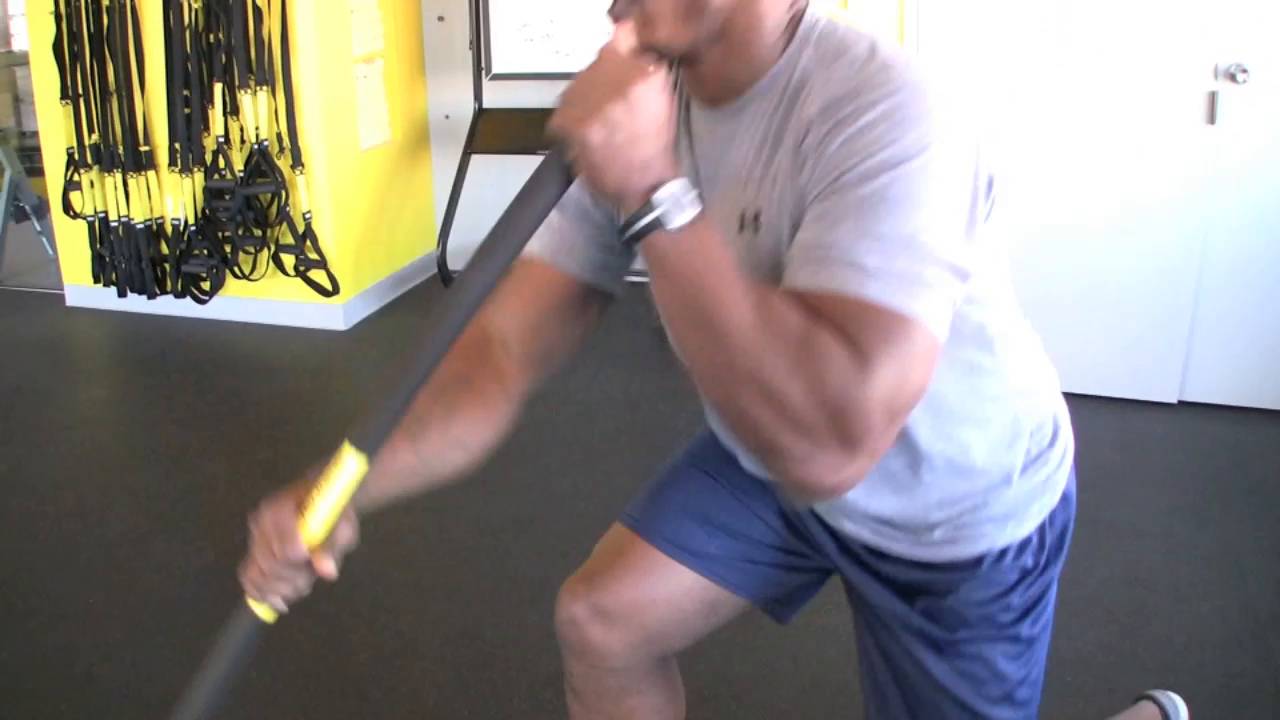
HIIT Workout with the TRX Rip Trainer
Try this TRX high intensity interval training (HIIT) workout from inventor of the Rip Trainer Pete Holman and STACK.
If you are looking for the most effective way to achieve your fitness goals, you need to try high-intensity interval training (HIIT). HIIT workouts are a proven way to improve endurance, burn more fat faster and minimize training time, while still increasing strength and power. Ready to get started with HIIT but not sure which intensity level is right for you? Take our quick fitness assessment quiz to get a personalized HIIT program tailored to your current fitness level and goals, helping you maximize results while training safely and effectively.
TAKE OUR TRAINING QUIZ
HIIT workouts involve performing exercises at maximum intensity for short durations followed by limited rest intervals. Each rep should be intense, rating at least an eight out of 10 on a perceived scale of exertion. If you aren't out of breath and gassed after a complete circuit, you are not working hard enough.
Performing the following TRX Rip Trainer HIIT circuit will "hit" every muscle in your body while targeting critical aspects of performance, including strength, balance, power, endurance and mental focus. Although intensity is important during HIIT training, attempt to progress to faster and more powerful movements, and never sacrifice control for intensity.
Rip WindmillThis exercise will load your core by activating your abdominals, hips, low back and scapular muscles. Developing these muscles will improve your posture, balance and power transfer and reduce the risk of back injury. In addition, performing this exercise at a high speed offers a tremendous metabolic challenge that will improve your overall endurance and increase fat burn.
Stand sideways to the anchor point using an alternating grip
Draw circles with the end of the Rip Trainer, while squatting up and down
Perform for 30 seconds at high speed, rest for 15 seconds and proceed to the next exercise
Rip KayakThe Rip Kayak develops your posterior chain (muscles in the back of your body) in an offset foot position to challenge your balance. This will increase pulling power in a balanced position, while still challenging your heart and lungs.
Stand in an offset stance facing the anchor point with an alternating grip, as if holding an oar
Pull the Rip Trainer back and return to start position in an arching path, as if rowing
Focus on pulling your shoulder blades back and follow the same path each rep
Don't let the cord hit the side of your leg
Perform for 30 seconds at high speed, rest for 15 seconds and proceed to the next exercise
Rip 90-Degree Jump PressThis exercise is about speed, power and agility. It mimics an Olympic-style lift, but it adds a rotational component to challenge your core. It should be performed with max effort each rep while maintaining a wide, stable base and using perfect technique. Be prepared to be gassed after this exercise.
Stand with the anchor point to your side
Hold the Rip Trainer at your chest with an overhand grip
Jump 90 degrees away from anchor point and aggressively press the bar off your chest
Perform for 30 seconds at high speed, rest for 30 to 60 seconds and repeat the circuit on the opposite side
If you haven't purchased your TRX Rip Trainer, get it here.
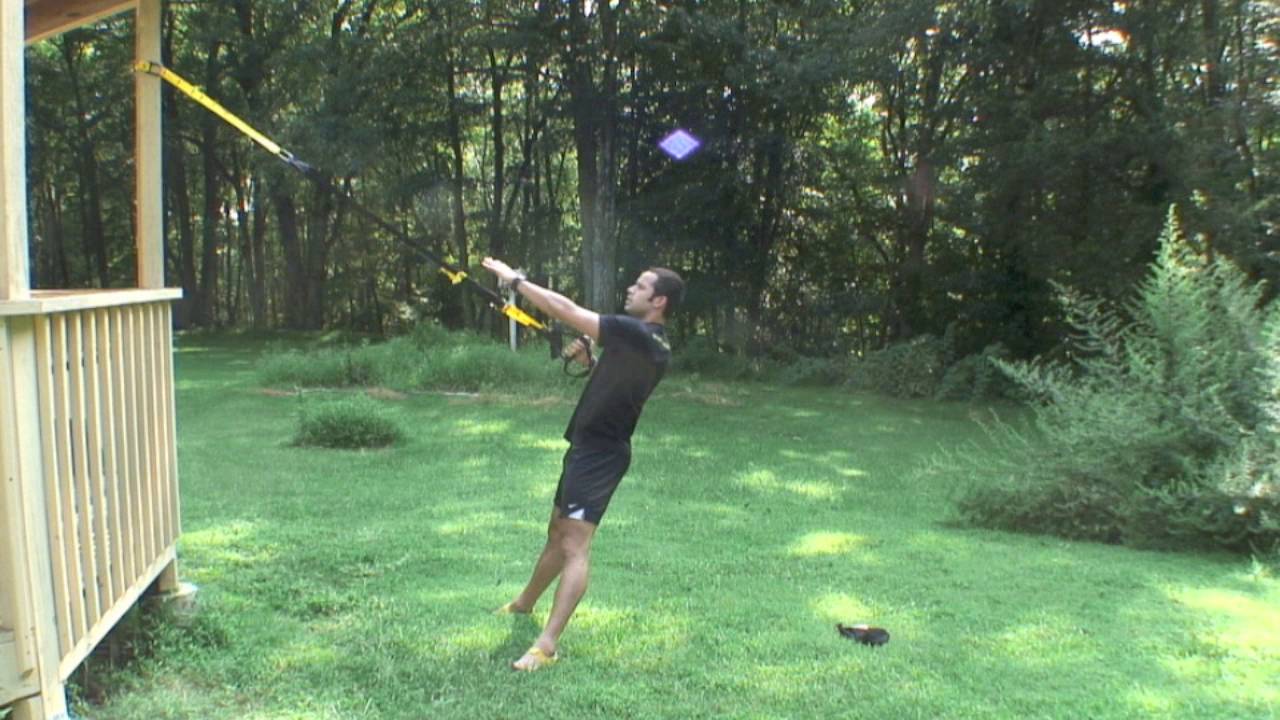
High Intensity Interval Training with TRX
It seems our three-part series on high intensity interval training (HIIT) from Mike Boyle sparked your interest (to read part 1, click here). To recap, HIIT uses specific, scientifically proven, work-to-rest ratios that map to corresponding heart rate zones. It's an intense form of interval training that produces rapid and dramatic changes to your body and cardiovascular system. We've received a lot of feedback from the TRX Community asking how to perform HIIT on the TRX Suspension Trainer. Here to show you how is Master Trainer Marc Coronel.
TAKE OUR TRAINING QUIZ
One of the more common and well-known forms of HIIT is a Tabata interval. Developed by Dr. Izumi Tabata in 1996 to test the effects of HIIT on speed skaters, he set the work-to-rest ratio at 2:1. Athletes performed 20 seconds of work followed by 10 seconds of recovery for a total of four minutes of work.
In the video above, Marc follows the same work-to-rest ratio, performing 20 seconds of work followed by 10 seconds of rest. He only performs one round in the video for demonstration purposes, but you'll need to perform the exercises on both sides, completing as many rounds as possible for a total of four minutes.
Though we typically advocate form over intensity, Marc incorporates the Suspension Trainer with some movements (the TRX Power Pull, the TRX Burpee and the TRX Single Leg Oblique Crunch) that can quickly jack up the heart rate without sacrificing too much technique. You'll notice Marc keeps the Suspension Trainer at mid-calf length to allow for smooth transitions between the exercises while maintaining his 10 second rest interval.
HIIT works awesome for burning fat, building endurance and making the best use of your time, but there is a little more to it than just breathing hard and working up a sweat. Remember, try to make sure all of the exercises you choose use the same length adjustment and are hard enough to get your heart rate up in a short period of time. Give it a shot, be safe and respect the technique.
If you don't have a suspension trainer, pick one up today.
TRX® PRO4 SYSTEM
BUY NOW
TRX® HOME2 SYSTEM
BUY NOW
TRX® TACTICAL GYM
BUY NOW
Have you incorporated the TRX into your HIIT with clients? Tell us about it below.

High Intensity Interval Training on the TRX
High intensity interval training (HIIT) techniques like tabata intervals can be used to supercharge your TRX Suspension Training or Rip Training workouts. The basic HIIT technique is to alternate periods of extremely high intensity exercise with short rest periods for a specified number of sets. Looking to find the perfect HIIT routine for your fitness level? Our quick assessment quiz can help create a customized interval training plan that matches your goals.
TAKE OUR TRAINING QUIZ
This simple formula can be sliced and diced literally hundreds of different ways to target your exact goals, whether they're enhancing athletic performance or your appearance. You manipulate the work and rest intervals to create the optimal training result. If you're new to HIIT or just want a simple approach to experiment with, try using a 2:1 work-to-rest ratio applied to four different TRX Suspension Training movements.
Using this approach, your workout might look like this:-5 x (:20 work, :10 rest) TRX Jump Squat-Rest one minute-5 x (:20 work, :10 rest) TRX Hamstring Runner-Rest one minute-5 x (:20 work, :10 rest) TRX Chest Press-Rest one minute-5 x (:20 work, :10 rest) TRX Low RowTry this sequence at the end of your usual workout, or use it as a standalone workout when you’re short on time. This is a tabata-like protocol that will be extremely challenging. The key to getting results using any HIIT workout is to push yourself as hard as possible during the work portion of the interval and to avoid the temptation to do anything except rest during the rest portion of the interval.Tweak the ratio of work/rest and the length of the intervals to suit your specific needs. Get after it, then find more HITT workouts here.
Pick up your TRX Suspension Trainer here.
